When government and business both fail to provide what people need, it may be more effective to build dual power and help communities help themselves.
Unless you’re lucky (or unscrupulous) enough to be an isolated billionaire, you’ve probably noticed that the world is coming apart around us. In just the last few weeks, news stories have chronicled the decline. Nearly half of American families with kids can’t afford enough food since the boosted child tax credit expired. Failed, aging infrastructure left the city of Odessa, TX, without water. Gas prices are surging, due to broken refineries and supply disruptions. Climate patterns are shifting, leaving some places too hot and dry, or far too wet. Neither government nor business is going to help. So we’ll have to help each other, and building dual power structures is the way to make it happen.
Think about where leadership and power come from in our current society. The first power structure you might think of is government, since they’re the ones with the laws, police, prisons, and the (more or less) legitimate monopoly on violence to enforce their will on all of us. Since the power of government has become entangled with the power of money and commerce, it’s fair to count business interests as part of that power structure too. After all, when roughly half of Americans aren’t able to come up with $500 to cover an emergency expense, we’re beholden to companies to both pay us a living wage and provide the goods and services that everybody needs at an affordable price. That’s a lot of power, maybe more than they deserve to wield.
Dual power, however, implies at least two competing power structures, and what’s the alternative one? That is the one that everyday people like us can and should build for ourselves.
Justin King, a journalist and YouTuber who goes by the moniker “Beau of the Fifth Column,” describes one way of building dual power in his videos about community networks. These are groups of people “helping each other, and making their community better,” he explains. People are often part of many different networks, whether it’s the connections they have to neighbors, colleagues they work with, religious and social groups, friends and family members. The key is to bring all of those connections, resources and abilities together in ways that help people and communities get what they need.
In this video, King lays out how his network assisted with disaster relief after Hurricane Michael hit Panama City, FL in 2018. After he cleared out his own driveway, he and his network connected donated resources from as far away as Ohio with people who desperately needed help, whether it was in the form of baby formula and diapers, or tarps and help covering holes in a roof, or cleaning supplies and clotheslines for laundry in the absence of electricity. Churches, for example, might serve as a collection point for supplies. Aid came from other neighborhoods, social groups, even individuals giving what they could. There was even a woman in a wheelchair who monitored social media looking for requests for aid, passing those messages along to drivers while highlighting routes on a map that had been cleared. No matter your skillset, there’s almost always a way to help.

Even without a natural disaster, our cascading collapse is enough of a disaster for community networks to be a real help, outside of the government/business framework. All it takes is the inclination to make the world a better place, and the willingness to step up and put that vision into action. The Black Panthers providing free, nutritious breakfasts for hungry kids built dual power in 1969. When the eight licensed subsistence fishermen in the Indigenous community of Port Heiden, Alaska, donate a day to haul in and distribute salmon to keep families and elders fed over the winter, the same thing happens today.
When the benefits these networks provide are felt by the community, people may start to turn to them instead of businesses and governments, which, all too often, fail to deliver. That’s where the “dual” part of dual power comes in. The best place to start is to find the needs that aren’t being met by the current power framework, and these days, finding unmet needs should not be difficult. Marshalling resources to meet them may be, but as Justin King explains, everybody has a role they can play. Some people have more time, some people have no time but can provide money, some people have needed skills. A successful organizer who puts it all together might find themselves rather important in the community, and can leverage that popularity to launch a political campaign, for example. Or maybe people begin thinking about power altogether differently.
It’s important to realize that dual power can only do so much. However, systems are breaking down around us, and preserving the status quo will not be possible forever. As governments become bogged down in partisan chaos and lose effectiveness, and as businesses squeeze workers and trash the living world to grasp at profits above all else, something or someone will naturally step into the void. Starting networks and building dual power structures can help assure that the void is filled by those who have our best interests at heart and help prevent a turn to sweet-talking demagogues who promise much and deliver little. We won’t get everything we want, but we might get a lot more of what we really need.
Related: Social Welfare is for Radicals


Join the conversation!